Text
indefinite hiatus !!
hello, cool people :-) hope you enjoyed the horror week event.
in other news, i am stopping FOTD & leaving this blog altogether indefinitely :-( i've had a really fun time but due to health issues & a super busy schedule i can't continue.
take care<3
101 notes
·
View notes
Text
HORROR WEEK- FOTD #150 - red-juice tooth! (hydnellum peckii)
the red-juice tooth (also strawberries & cream, bleeding hydnellum, bleeding tooth fungus, & devil's tooth) is a hydnoid fungus in the family bankeraceae :-) it is mycorrhizal & forms associations with conifers across north america.
the big question : will it kill me?? not at all !! it's edible. however, the blood-red guttation is extremely bitter. ^^"

h. peckii description :
"the fruit bodies typically have a funnel-shaped cap with a white edge, although the shape can be highly variable. young, moist fruit bodies can "bleed" bright red guttation droplets."
[images : source] [fungus description : source]
#• fungus of the day !! •#[hydnellum peckii]#: bleeding tooth :#: red-juice tooth :#: strawberries & cream :#150#||#fungus#mushrooms#fungi#earth#nature#cottagecore#mushroom#foraging#forestcore#mycology#blood#tw blood#cw blood#halloween
326 notes
·
View notes
Text
HORROR WEEK- FOTD #149 - octopus stinkhorn! (clathrus archeri)
the octopus stinkhorn - or devil's fingers - is a stinkhorn fungus found across the world. it forms part of the phallaceae family, & can be found in areas with high amounts of decaying organic matter. it has also become a bit of an invasive species. it was chosen for horror week because it's super gross !! it stinks !! it has tentacles !!
the big question : will it kill me?? urhm. so. i don't know !! no one knows. it smells like rotting flesh so i don't suppose anyone is very keen on trying?
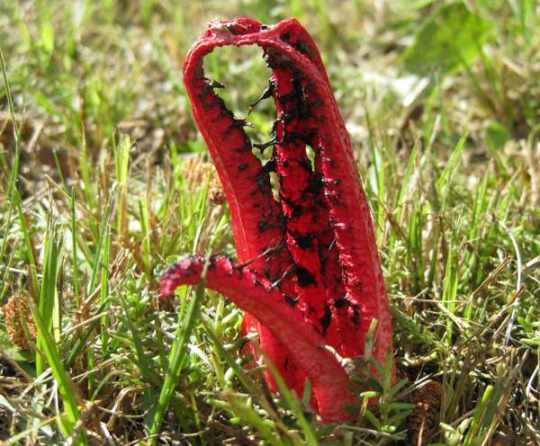
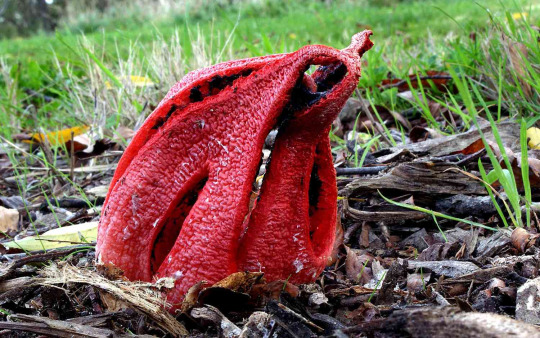
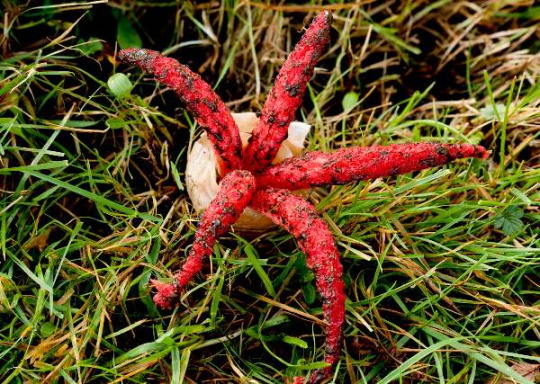
c. archeri description :
"the young fungus erupts from a suberumpent egg by forming into four to seven elongated slender arms initially erect & attached at the top. the arms then unfold to reveal a pinkish-red interior covered with a dark-olive spore-containing gleba."
[images : source, source & source] [fungus description : source]
#• fungus of the day !! •#[clathrus archeri]#: devil's fingers :#: octopus stinkhorn :#149#||#mushroom#earth#nature#cottagecore#mushrooms#foraging#forestcore#mycology#fungus#fungi#fotd#fungus of the day
141 notes
·
View notes
Text
HORROR WEEK- FOTD #148 : dead man's fingers! (xylaria polymorpha)
dead man's fingers is a saprobic fungus in the family xylariaceae. it commonly grows on rotting tree stumps in mainland europe & parts of north america. it is classified as a sac fungus !! this fungus was chosen for horror week because.. well.. it's a little obvious >:-)
the big question : will it kill me?? nah, but it's still inedible. ^^"


x. polymorpha description :
"the dark fruiting body (often black or brown, but sometimes shades of blue/green) is white on the inside, with a blackened dotted area all around. this blackened surrounding area is made up of tiny structures called perithecia."
[images : source & source] [fungus description : source]
#• fungus of the day !! •#[xylaria polymorpha]#: dead man's fingers :#148#||#mycology#fungus#fungi#mushroom#earth#nature#mushrooms#foraging#forestcore#cottagecore#fotd#fungus of the day
184 notes
·
View notes
Note
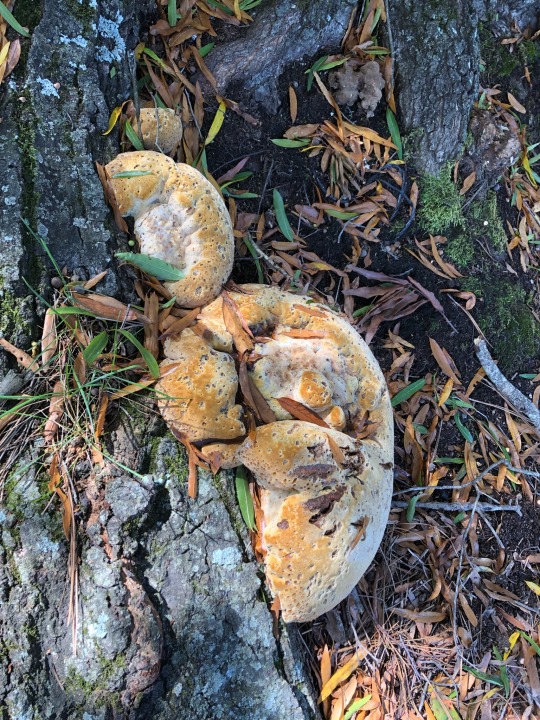
Friends on a tree root! I don’t know them but they’re neat!
very cool<3 love a good bracket fungus
24 notes
·
View notes
Note
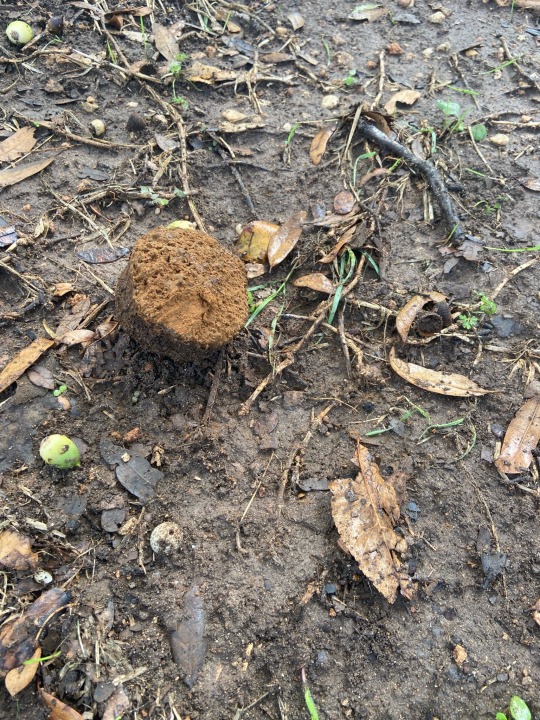
Hello! I found this on a rainy walk. I poked it with my shoe and brown dust came off and out. I backed away and washed my shoe. It looks very cool and intimidating! Do you know what this is?
based on what happened, i am assuming this was a giant puffball !! however, in the image it just looks like a ball of shit so it's up to you whether or not you think that's accurate😭
here is some information about the giant puffball if you're curious :-)
11 notes
·
View notes
Text
HORROR WEEK- FOTD #147 : zombie-ant fungus! (ophiocordyceps unilateralis)
the zombie-ant fungus is an insect-pathogenic fungus that infects & controls the muscular system of an ant. it is a member of the ophiocordycipitaceae family, & has received notoriety in popular media after inspiring parts of the hit series & game 'the last of us'. it mainly occurs in tropical forest ecosystems :-)
the big question : will it kill me?? only if you're an ant :-) if you're an ant, the fungus will take control of your body - not your mind, as is commonly falsely believed - force you to climb about a foot off the ground into a tree, latch your jaw into a "death grip" on the vein of a leaf, & sprout from your body !! you will be eaten from the inside.


[images : source & source] [fungus description : none]
#• fungus of the day !! •#[ophiocordyceps unilateralis]#: zombie-ant fungus :#147#||#fotd#bug#death#dead bug#dead bugs#ant#mushrooms#mushroom#earth#nature#fungus#cottagecore#mycology#fungi#forestcore#foraging#fungus of the day#ophiocordyceps unilateralis#zombie-ant fungus
109 notes
·
View notes
Text
HORROR WEEK- FOTD #146 : purple jellydisc! (ascocoryne sarcoides)
the purple jellydisc (also jelly drops) is a jelly fungus in the family helotiaceae :-) it was picked for horror week due to its gross, brain-like appearance !! this fungus is saprotrophic, & plays a very important role in the process of tree decay. so far, it has been recorded in finland, france, great britain, germany, norway, chile, australia, china, cuba, iceland, taiwan, hawaii & korea. a fun fact is that this fungus can reproduce both sexually & asexually !!
the big question : will it kill me?? nah, but it's not considered edible either.

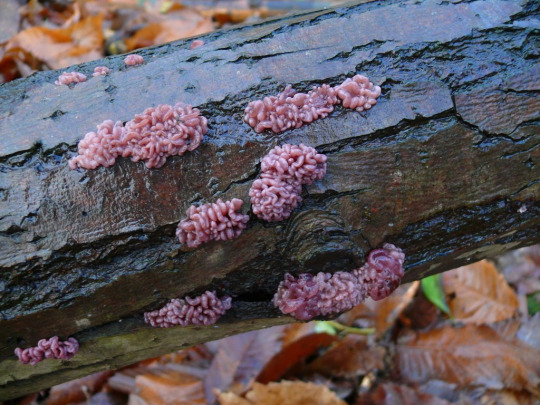
a. sarcoides description :
"this fungus is characterized by a fruiting body (technically an apothecium) with a pinkish-purple colour & more or less gelatinous consistency. the apothecia, typically 0.5 to 1.5 centimetres (1⁄4 to 5⁄8 in) in diameter, start with a roughly spherical shape, then eventually flatten out to become shallowly cup-shaped with a wavy edge and smooth upper surface. the lower surface may be covered with small particles (granular), & the apothecia are either attached directly to the growing surface (sessile), or have a rudimentary stem. the apothecia are accompanied by a conidial form, where non-sexual spores are generated. the conidial form consists of sporodochia, a cushion-like asexual fruiting body mass consisting of short conidiophores (specialized stalks that bear conidia). the sporodochia are similar in colour & consistency to the apothecia but very variable in shape, typically club-, spoon-, or tongue-shaped, & bearing minute, cylindrical, straight or curved conidia. as the fungus matures & the apothecia enlarge & press against each other, the apothecia coalesce to form a gelatinous, irregular mass. the flesh, similar to the appearance of the fungus, is pinkish-purple & gelatinous."
[images : source & source] [fungus description : source]
#• fungus of the day !! •#[ascocoryne sarcoides]#: purple jellydisc :#: jelly drops :#146#||#fotd#fungus of the day#ascocoryne sarcoides#purple jellydisc#jelly drops#jelly#jelly fungus#fungus#mushrooms#mushroom#cottagecore#nature#foraging#earth#forestcore#mycology#fungi
114 notes
·
View notes
Text
HORROR WEEK- FOTD #145 : death cap! (amanita phalloides)
the death cap (sometimes also stinking amanita or deadly amanita) is an agaric fungus in the family amanitaceae :-) it was originally widely distributed in europe, but was later introduced to other countries across the world. it forms ectomycorrhizal associations with broadleaf trees !!
the big question : will it kill me?? it will kill you SO BAD. you will BE SO DEAD. it is the most toxic mushroom currently known to science :-3 "the toxins of the death cap mushrooms primarily target the liver, but other organs, such as the kidneys, are also affected. symptoms of death cap mushroom toxicity usually occur 6 to 12 hours after ingestion. symptoms of ingestion of the death cap mushroom may include nausea & vomiting, which is then followed by jaundice, seizures, & coma which will lead to death. the mortality rate of ingestion of the death cap mushroom is believed to be around 10–30%." the "most fun" part is, they're easy to confuse with many edible mushrooms.
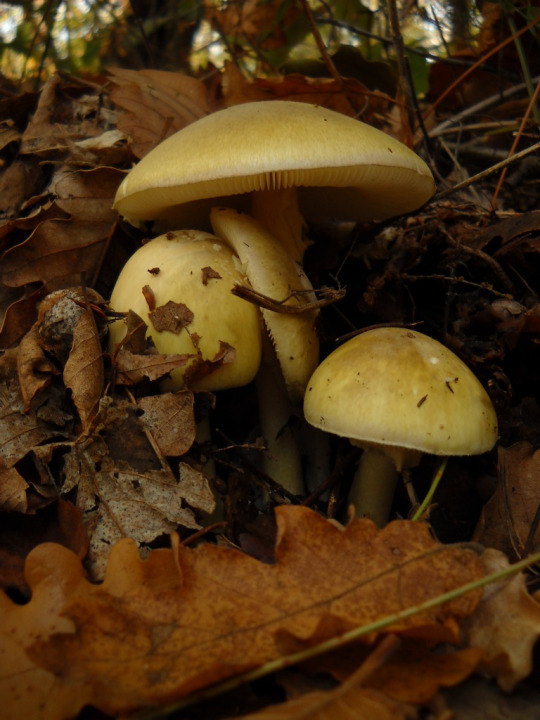
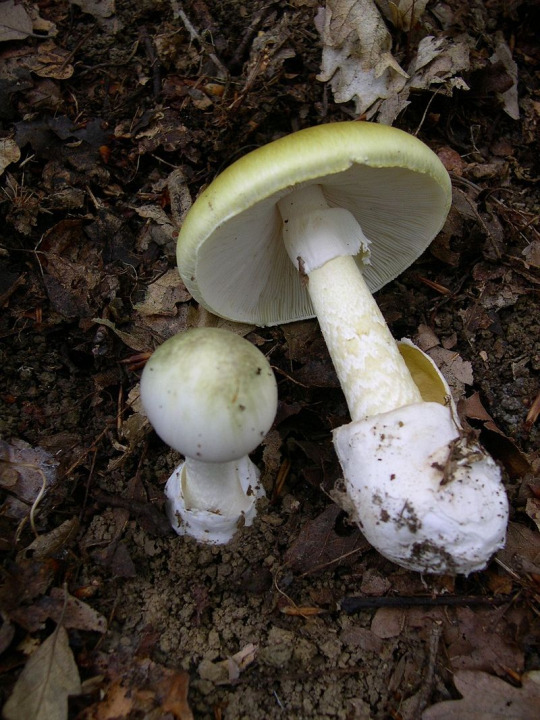
a. phalloides decription :
"the death cap has a large & imposing epigeous (aboveground) fruiting body (basidiocarp), usually with a pileus (cap) from 5 to 15 centimetres (2 to 5+7⁄8 inches) across, initially rounded and hemispherical, but flattening with age. the colour of the cap can be pale-green, yellowish-green, olive-green, bronze, or (in one form) white ; it is often paler toward the margins, which can have darker streaks ; it is also often paler after rain. the cap surface is sticky when wet & easily peeled—a troublesome feature, as that is allegedly a feature of edible fungi. the remains of the partial veil are seen as a skirtlike, floppy annulus usually about 1 to 1.5 cm (3⁄8 to 5⁄8 in) below the cap. the crowded white lamellae (gills) are free. the stipe is white with a scattering of greyish-olive scales & is 8 to 15 cm (3+1⁄8 to 5+7⁄8 in) long & 1 to 2 cm (3⁄8 to 3⁄4 in) thick, with a swollen, ragged, sac-like white volva (base). as the volva, which may be hidden by leaf litter, is a distinctive & diagnostic feature, it is important to remove some debris to check for it."
[images : source] [fungus description : source]
"GUYS !! it's her<3 i love her so fucken much."
#• fungus of the day !! •#[amanita phalloides]#: death cap :#: deadly amanita :#: stinking amanita :#145#||#mycology#fungus#earth#nature#cottagecore#foraging#mushroom#forestcore#mushrooms#fungi#fotd#fungus of the day#amanita phalloides#death cap#death#emeto#vomit#dying
60 notes
·
View notes
Text
HORROR WEEK- FOTD #144 : apple bolete! (exsudoporus frostii)
the apple bolete (also frost's bolete) is a mycorrhizal fungus in the family boletaceae >:-) it typically grows near the hardwood trees of the eastern US, southern mexico & costa rica. it was chosen for horror week due to its appearance being reminiscent of muscle tissue !!
the big question : will it kill me?? nope !! however, although they are edible, they are not recommended for consumption as it is quite easy to confuse them with other red boletes. ^^
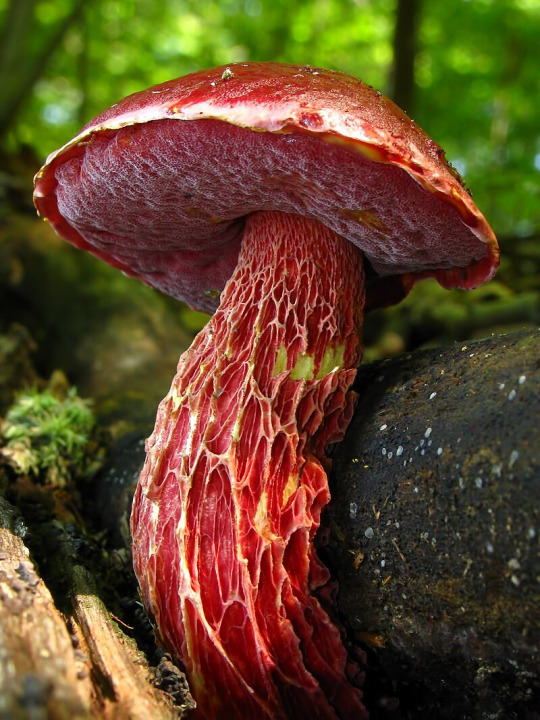
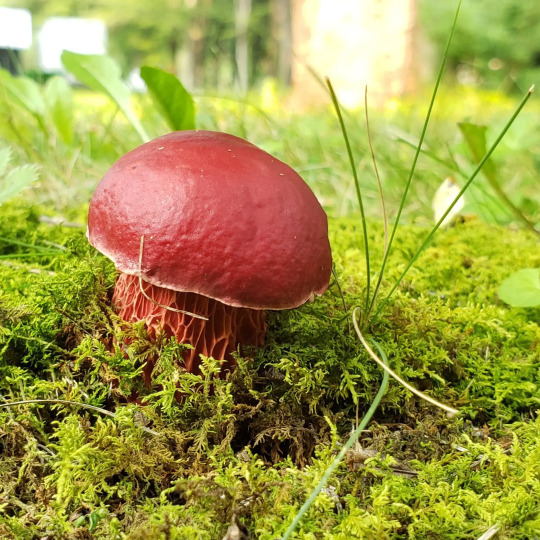
e. frostii description :
"the shape of the cap of the young fruit body ranges from a half sphere to convex, later becoming broadly convex to flat or shallowly depressed, with a diameter of 5–15 cm (2.0–5.9 in). the edge of the cap is curved inward, although as it ages it can uncurl and turn upward. in moist conditions, the cap surface is sticky as a result of its cuticle, which is made of gelatinized hyphae. if the fruit body has dried out after a rain, the cap is especially shiny, sometimes appearing finely areolate (having a pattern of block-like areas similar to cracked, dried mud). young mushrooms have a whitish bloom on the cap surface.
the colour is bright red initially, but fades with age. the flesh is up to 2.5 cm (1.0 in) thick, & ranges in colour from pallid to pale yellow to lemon yellow. the flesh has a variable staining reaction in response to bruising, so some specimens may turn deep blue almost immediately, while others turn blue weakly & slowly.
the tubes comprising the pore surface (the hymenium) are 9–15 mm deep, yellow to olivaceous yellow (mustard yellow), turning dingy blue when bruised. the pores are small (2 to 3 per mm), circular, & until old age a deep red colour that eventually becomes paler. the pore surface is often beaded with yellowish droplets when young (a distinguishing characteristic), & readily stains blue when bruised. the stipe is 4 to 12 cm (1.6 to 4.7 in) long, & 1 to 2.5 cm (0.4 to 1.0 in) thick at its apex. it is roughly equal in thickness throughout its length, though it may taper somewhat toward the top ; some specimens may appear ventricose (swollen in the middle). the stipe surface is mostly red, or yellowish near the base ; it is reticulate — characterized by ridges arranged in the form of a net-like pattern."
[images : source & source] [fungus description : source]
#• fungus of the day !! •#• horror week >:-) •#[exsudoporus frostii]#: frost's bolete :#: apple bolete :#144#||#image undescribed#fungi#undescribed#mushroom#mushrooms#earth#nature#cottagecore#fungus#foraging#forestcore#mycology#fotd#fungus of the day#exsudoporus frostii#frost's bolete#apple bolete#bolete
242 notes
·
View notes
Note
I guessed the first one bc I saw the second one had a volva and the spaced out white spots reminded me of amanita muscaria. But I was wondering if these are generally characteristics of non-edible fungi or no?
i know you're just trying to make connections & use logic, but this is a terrible idea when mushroom-hunting !!
yes, the volva & the white warts are similar to amanita muscaria, a poisonous mushroom. however, they are just characteristics of amanitas & hold no bearing on whether or not it is dangerous.
to answer your question - no. there is no "sign" that a fungus is poisonous. animals have that "bright colour means stay away" rule, but there is no such rule for fungi. the only way to know if a species is poisonous is by being able to identify it, & having the knowledge of whether or not that specific species can harm you.
18 notes
·
View notes
Note
seeing that we don’t know the edibility of some of these mushrooms makes me sad :( someone should go out and try them all
ME ME ME ME ME ME ME ME ME ME ME ME ME ME ME ME ME ME ME ME ME ME ME ME ME ME ME ME ME ME ME ME ME ME ME ME ME ME ME ME ME ME ME ME ME ME ME ME ME ME ME ME ME ME ME ME ME ME ME ME ME ME ME ME ME ME ME ME ME ME ME ME ME ME ME ME ME ME ME ME ME ME ME ME
27 notes
·
View notes
Note
Hello, can I know which of the mushrooms was safe? Was it the panther or amanita please?
they were both amanitas !! as i said, the panther cap is the dangerous one.
the panther cap was the one on the right !!
4 notes
·
View notes
Text
FOTD #143 : fairy inkcap! (coprinellus disseminatus)
the fairy inkcap (also fairy bonnet, or trooping crumble cap) is an inkcap agaric fungus in the family psathyrellaceae. they are known for growing in huge clusters !! interestingly, unlike the name implies this fungus does not dissolve into ink in maturity. ^^
the big question : can i bite it?? yes - this species is non-poisonous.
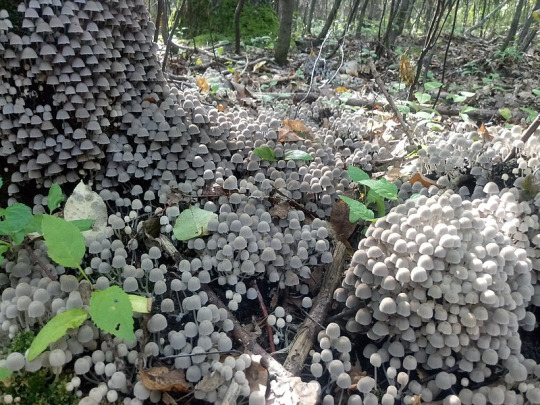
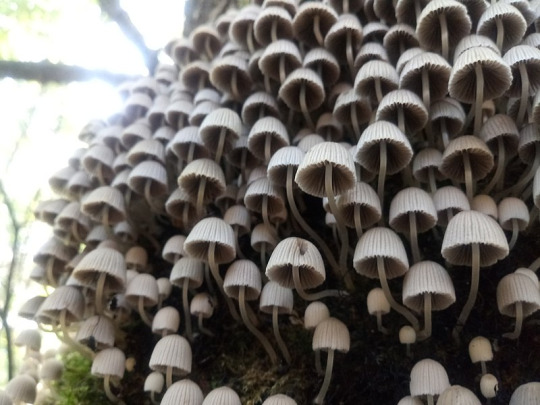
[images : source]
#• fungus of the day !! •#[coprinellus disseminatus]#: fairy inkcap :#: fairy bonnet :#: trooping crumble cap :#143#||#fungus#mushrooms#mycology#mushroom#earth#fungi#foraging#forestcore#cottagecore#nature
807 notes
·
View notes
Text
FOTD #142 : southern cinnabar polypore! (pycnoporus coccineus)
the southern cinnabar polypore is a white-rot saprotrophic fungus in the family polyporaceae. its hymenium is covered in pores & it lacks a stipe !!
the big question : can i bite it?? the edibility of this fungus is currently unknown. ^^
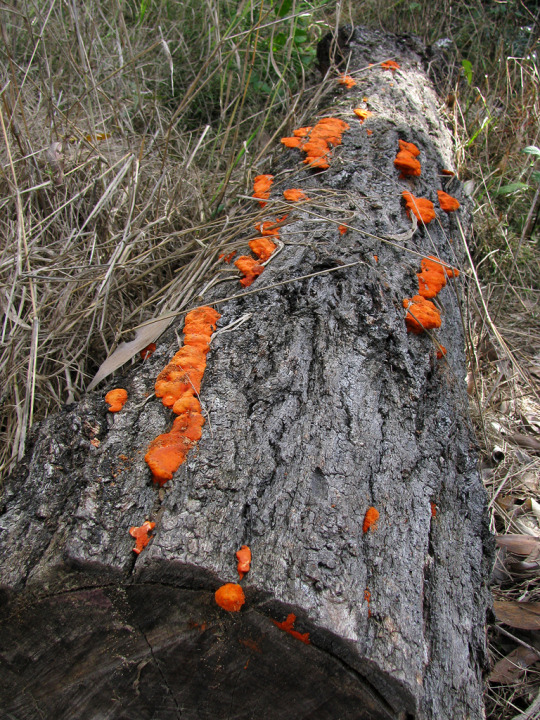

[images : source & source] [fungus description : couldn't find one ;-;]
#• fungus of the day !! •#[pycnoporus coccineus]#: southern cinnabar polypore :#142#||#mushrooms#fungus#mushroom#earth#nature#fungi#cottagecore#foraging#forestcore#mycology#image undescribed#undescribed#fotd#fungus of the day
83 notes
·
View notes
Text
FOTD #141 : chicken lips! (leotia viscosa)
chicken lips are a species of mushroom-producing fungus in the family leotiaceae. there is little currently know about it !! it can be found growing on dead logs (it is saprotrophic), or under conifer trees.
the big question : can i bite it?? the edibility is currently unknown. ^^
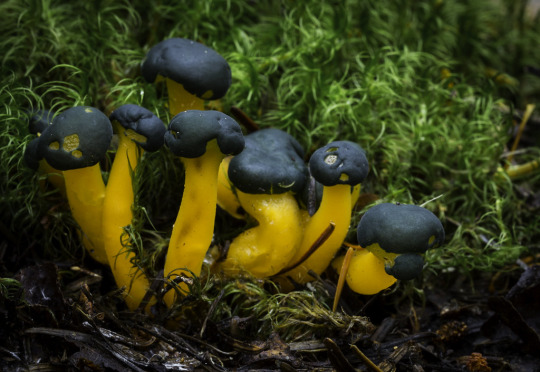
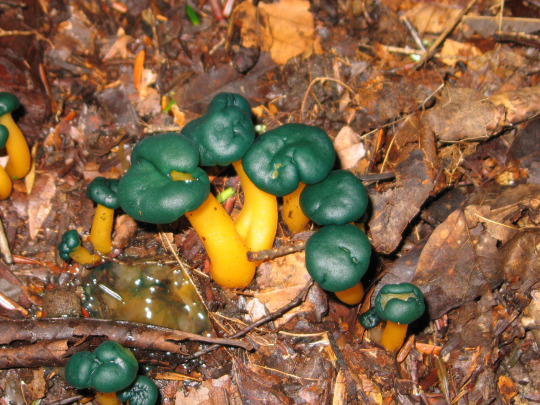
l. viscosa description :
"its stem colour can be yellow, orange to white, & the cap is green. the cap comes in a variety of shapes."
[images : source & source] [fungus description : source]
#• fungus of the day !! •#[leotia viscosa]#: chicken lips :#141#||#mushroom#earth#mushrooms#nature#cottagecore#foraging#mycology#fungus#forestcore#fungi#leotia viscosa#chicken lips#fotd#fungus of the day#image undescribed#undescribed
131 notes
·
View notes
Text
FOTD #140 : nargan's bonnet! (mycena nargan)
nargan's bonnet (also spotted pixie cap) is a saprotrophic fungus in the family mycenaceae. it has been discovered across australia & tasmania, most notably in victoria :-) it is quite new to science, & was only discovered in the early 90s !!
the big question : can i bite it?? nah - the edibility is currently unknown.
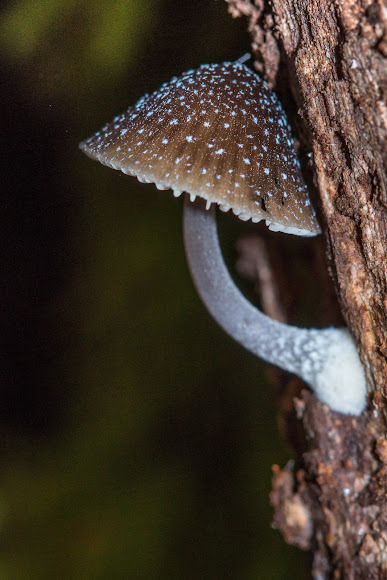

m. nargan description :
"the caps of young mushrooms are initially egg-shaped to conical, expanding to become bell-shaped & up to 2 cm (0.8 in) in diameter. initially, the margin of the cap is rolled inwards ; it typically assumes a lighter colour than the centre of the cap surface. dark brown in colour, the mushroom is distinguished by the presence of white speckles or scales on the cap and stem ; these scales may disappear when they become sloughed off or washed away by rain, which can make the species hard to recognise. the thick gills have an adnate attachment to the stem (broadly attached to the stem slightly above the bottom of the gill, with most of the gill fused to the stem), & are white to light grey in colour, paler toward the edge. there are about 24–28 gills extending completely from the cap margin to the stem, & one or two tiers of lamellulae (shorter gills does do not extend fully from the margin to the stem). the thin stem is up to 4 cm (1.6 in) high & 0.3 cm (0.12 in) wide, & does not have a ring. young specimens will typically have whitish scales at the base ; later, these will slough off & a felt-like whitish mycelium may be apparent."
[images : source & source] [fungus description : source]
#• fungus of the day !! •#[mycena nargan]#: nargan's bonnet :#140#||#fungus#mushrooms#fungi#mycology#nature#cottagecore#earth#foraging#forestcore#mushroom#fotd#fungus of the day#mycena#mycena nargan#nargan's bonnet#image undescribed#undescribed
138 notes
·
View notes